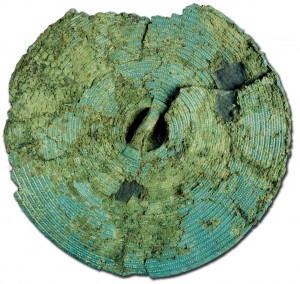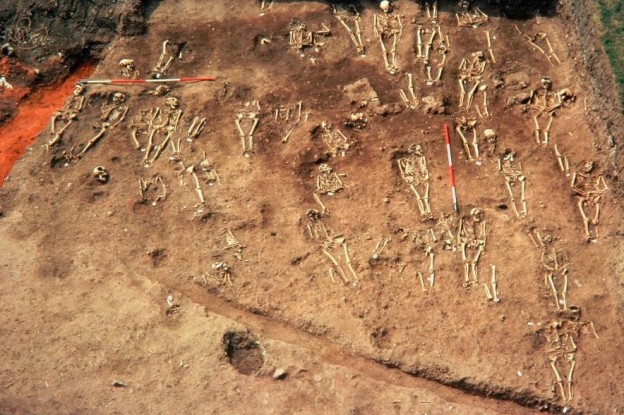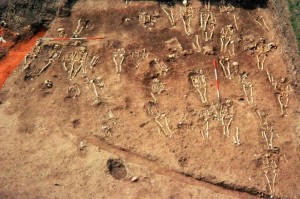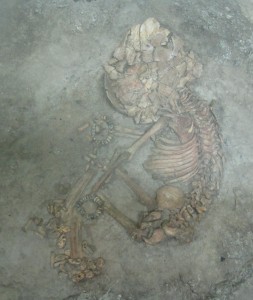We were treated to a very different kind of research seminar on Friday when three of our PhD researchers bravely took the stage to present on their work. The three students had recently given these papers at EAA Glasgow and were invited to share them with the department, which was great for those who couldn’t make it to Scotland in September! In a break from the usual format, each student gave a 20 minute presentation followed by questions. The turnout was fantastic, it was great to see such support for postgraduate research! There was even a live tweet going on – follow it with the hashtag #PGtakeover.

The Cadbury Shield, deposited in the ground and stabbed repeatedly with a wooden stake. Courtesy of Steven Minnitt (South West Heritage Trust (Museums Service))
Matt Knight: Putting Out-of-time metalwork in its place: Commemorating and forgetting traditions in Bronze Age Southern Britain.
Matt spoke about the phenomenon of finding earlier bronze objects in later Bronze Age contexts. He argues that these ‘out-of-time’ objects have much to inform us about the ways in which past societies conceived their own past. He gave examples of deposits made in significant locations in the landscape or within settlements and suggested that they could be used to reinforce community boundaries and links with ancestors by including heirloom objects or objects involved in significant practices in the past. He concluded by suggesting that these depositions were events of commemoration, legitimisation and/or forgetting.
Mandy Kingdom: Burial in Medieval Exeter. Development and changes in practice from post-Roman to Early Medieval period.
Mandy used archaeological records, radiocarbon dating, historical sources and osteological to gain new insights into the development of the Exeter Cathedral cemetery over almost 1000 years. She highlighted the first burials inside the walls, RC dated to between AD 390-650, which show the ceasing of Roman administration over burial. After the Norman conquest the Cathedral had monopoly over burial and funerals, and the costs thereof. The majority of the burials date from the middle Saxon period to 1636 when the cemetery was closed due to overcrowding. Mandy showed that alterations in the alignment of inhumations and different treatment of charnel material suggests that the administration of the cemetery and the attitude to its occupants changed on a number of occasions during its use.
Belinda Tibbetts: Perinatal death and cultural buffering in a Neolithic Community.
Belinda investigates the skeletal palaeopathology of very young individuals as an indicator for maternal health for her PhD. She presented skeletal evidence around 8 thousand years old from Çatalhöyük, employing a bioarchaeological approach to understanding the burial remains of neonates within the context of the cultural response to infant death that is reflected in the archaeological record. She found that the infants were being treated in the same way as other individuals at other life stages, suggesting that the people of Çatalhöyük had social identity regardless of age-at-death.
All of the talks were incredibly interesting and well presented. We’d like to thank our students for giving us such a great insight into their work.
Written by Emily Johnson.



